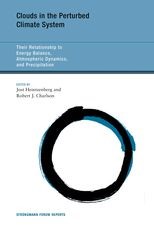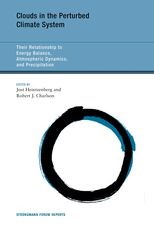Clouds in the Perturbed Climate System: Their Relationship to Energy Balance, Atmospheric Dynamics, and Precipitation
Clouds in the Perturbed Climate System: Their Relationship to Energy Balance, Atmospheric Dynamics, and Precipitation
Cite
Abstract
More than half the globe is covered by visible clouds. Clouds control major parts of the Earth’s energy balance, influencing both incoming shortwave solar radiation and outgoing longwave thermal radiation. Latent heating and cooling related to cloud processes modify atmospheric circulation, and, by modulating sea surface temperatures, clouds affect the oceanic circulation. They are also an essential component of the global water cycle, on which all terrestrial life depends. Yet clouds constitute the most poorly quantified, least understood, and most puzzling aspect of atmospheric science, and thus the largest source of uncertainty in the prediction of climate change. Because they are influenced by climate change, and because complex, unidentified feedback systems are involved, science is faced with many unanswered questions. This book begins by identifying and describing the baffling nature of clouds. It explores the boundaries of current knowledge on the spatial/temporal variability of clouds and cloud-related aerosols, as well as the factors that control clouds, and examines the extent and nature of anthropogenic perturbations. Particular emphasis is placed on the connections of clouds to climate through radiation, dynamics, precipitation, and chemistry, and on the difficulties in understanding the obvious but elusive fact that clouds must be affected by climate change. The book offers recommendations to improve the current state of knowledge and to direct future research in fields ranging from chemistry and theoretical physics to climate modeling and remote satellite sensing.
-
Front Matter
-
1
Introduction
-
2
Trends in Observed Cloudiness and Earth’s Radiation Budget: What Do We Not Know and What Do We Need to Know?
Joel R. Norris andAnthony Slingo
-
3
Climatologies of Cloud-related Aerosols
-
4
Cloud Properties from In-situ and Remote-sensing Measurements: Capability and Limitations
George A. Isaac andK. Sebastian Schmidt
-
5
Clouds and Precipitation: Extreme Rainfall and Rain from Shallow Clouds
Yukari N. Takayabu andHirohiko Masunaga
-
6
Temporal and Spatial Variability of Clouds and Related Aerosols: Theodore L. Anderson, Rapporteur
Andrew Ackerman and others
-
7
Laboratory Cloud Simulation: Capabilities and Future Directions
Frank Stratmann and others
-
8
Cloud-controlling Factors: Low Clouds
Bjorn Stevens andJean-Louis Brenguier
-
9
Deep Convective Clouds
Wojciech W. Grabowski andJon C. Petch
-
10
Large-scale Controls on Cloudiness
Christopher S. Bretherton andDennis L. Hartmann
-
11
Cloud-controlling Factors of Cirrus
Bernd Kärcher andPeter Spichtinger
-
12
Cloud-controlling Factors
A. Pier Siebesma Rapporteur and others
-
13
Cloud Particle Precursors
Sonia M. Kreidenweis and others
-
14
Cloud–Aerosol Interactions from the Micro to the Cloud Scale
Graham Feingold andHolger Siebert
-
15
Weather and Climate Engineering
William R. Cotton
-
16
Air Pollution and Precipitation
Greg Ayers andZev Levin
-
17
What Do We Know about Large-scale Changes of Aerosols, Clouds, and the Radiation Budget?
Teruyuki Nakajima andMichael Schulz
-
18
The Extent and Nature of Anthropogenic Perturbations of Clouds
Patrick Y. Chuang and others
-
19
Global Indirect Radiative Forcing Caused by Aerosols: IPCC (2007) and Beyond
Jim Haywood and others
-
20
Simulating Global Clouds: Past, Present, and Future
William D. Collins andMasaki Satoh
-
21
Observational Strategies from the Micro- to Mesoscale
Jean-Louis Brenguier andRobert Wood
-
22
Observational Strategies at Meso- and Large Scales to Reduce Critical Uncertainties in Future Cloud Changes
Anthony Illingworth andSandrine Bony
-
23
Aerosols and Clouds in Chemical Transport Models and Climate Models
Ulrike Lohmann andStephen E. Schwartz
-
24
Current Understanding and Quantification of Clouds in the Changing Climate System and Strategies for Reducing Critical Uncertainties
Rapporteur Johannes Quaas and others
-
End Matter
Sign in
Personal account
- Sign in with email/username & password
- Get email alerts
- Save searches
- Purchase content
- Activate your purchase/trial code
Institutional access
-
Sign in through your institution
- Sign in with a library card Sign in with username/password Recommend to your librarian
Institutional account management
Sign in as administratorPurchase
Our books are available by subscription or purchase to libraries and institutions.
Purchasing information| Month: | Total Views: |
|---|---|
| November 2022 | 1 |
| January 2023 | 1 |
| June 2023 | 1 |
| October 2023 | 1 |
| October 2023 | 1 |
| November 2023 | 1 |
| December 2023 | 1 |
| March 2024 | 1 |
| March 2024 | 1 |
| March 2024 | 3 |
| April 2024 | 2 |




Get help with access
Institutional access
Access to content on Oxford Academic is often provided through institutional subscriptions and purchases. If you are a member of an institution with an active account, you may be able to access content in one of the following ways:
IP based access
Typically, access is provided across an institutional network to a range of IP addresses. This authentication occurs automatically, and it is not possible to sign out of an IP authenticated account.
Sign in through your institution
Choose this option to get remote access when outside your institution. Shibboleth/Open Athens technology is used to provide single sign-on between your institution’s website and Oxford Academic.
If your institution is not listed or you cannot sign in to your institution’s website, please contact your librarian or administrator.
Sign in with a library card
Enter your library card number to sign in. If you cannot sign in, please contact your librarian.
Society Members
Society member access to a journal is achieved in one of the following ways:
Sign in through society site
Many societies offer single sign-on between the society website and Oxford Academic. If you see ‘Sign in through society site’ in the sign in pane within a journal:
If you do not have a society account or have forgotten your username or password, please contact your society.
Sign in using a personal account
Some societies use Oxford Academic personal accounts to provide access to their members. See below.
Personal account
A personal account can be used to get email alerts, save searches, purchase content, and activate subscriptions.
Some societies use Oxford Academic personal accounts to provide access to their members.
Viewing your signed in accounts
Click the account icon in the top right to:
Signed in but can't access content
Oxford Academic is home to a wide variety of products. The institutional subscription may not cover the content that you are trying to access. If you believe you should have access to that content, please contact your librarian.
Institutional account management
For librarians and administrators, your personal account also provides access to institutional account management. Here you will find options to view and activate subscriptions, manage institutional settings and access options, access usage statistics, and more.